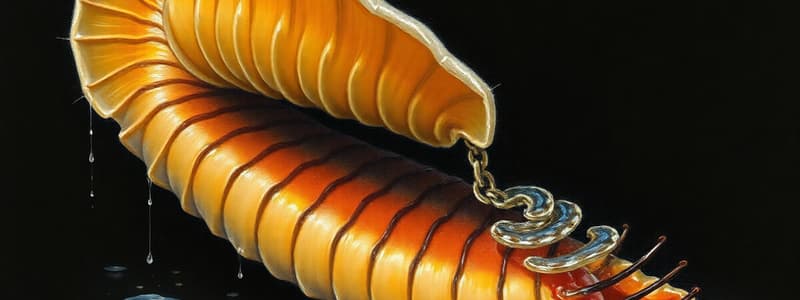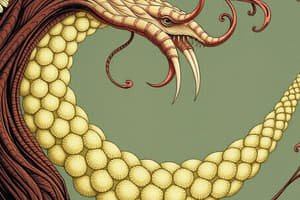Podcast
Questions and Answers
What is the name of the larval stage that takes up residence as a cyst in the intermediate host muscle?
What is the name of the larval stage that takes up residence as a cyst in the intermediate host muscle?
- Sporocyst
- Rediae
- Cysticercus (correct)
- Miracidium
Trematodes are a type of parasitic flatworm.
Trematodes are a type of parasitic flatworm.
True (A)
What is the primary method of reproduction for sporocysts and rediae?
What is the primary method of reproduction for sporocysts and rediae?
Asexual reproduction
The first intermediate host for trematodes is typically a ______.
The first intermediate host for trematodes is typically a ______.
Match the developmental stages of trematodes with their corresponding descriptions:
Match the developmental stages of trematodes with their corresponding descriptions:
What is the function of the penetration gland in the miracidium?
What is the function of the penetration gland in the miracidium?
Trematodes can only infect a single type of definitive host.
Trematodes can only infect a single type of definitive host.
Explain the role of the scolex in the life cycle of a trematode.
Explain the role of the scolex in the life cycle of a trematode.
What is the role of cercariae in the life cycle of trematodes?
What is the role of cercariae in the life cycle of trematodes?
Metacercariae can encyst in the skin or muscle of the second intermediate host.
Metacercariae can encyst in the skin or muscle of the second intermediate host.
Name a type of organism that can serve as a second intermediate host for trematodes.
Name a type of organism that can serve as a second intermediate host for trematodes.
The first intermediate host of trematodes is usually a ______.
The first intermediate host of trematodes is usually a ______.
Match the following stages of trematodes with their descriptions:
Match the following stages of trematodes with their descriptions:
What is the primary function of the scolex in cestodes?
What is the primary function of the scolex in cestodes?
Cestodes have a complete digestive system.
Cestodes have a complete digestive system.
What is a proglottid?
What is a proglottid?
Cestodes belong to the phylum ______.
Cestodes belong to the phylum ______.
Which of the following terms refers to the entire body of a cestode excluding the scolex?
Which of the following terms refers to the entire body of a cestode excluding the scolex?
Match the following components of cestodes with their definitions:
Match the following components of cestodes with their definitions:
The reproductive capacity of some large cestode species can reach up to ______ eggs per day.
The reproductive capacity of some large cestode species can reach up to ______ eggs per day.
Gamete exchange can occur between proglottids of the same worm.
Gamete exchange can occur between proglottids of the same worm.
Flashcards
Phylum Platyhelminthes
Phylum Platyhelminthes
A phylum of flatworms that includes classes such as Turbellaria and Cestoda.
Cestoda
Cestoda
Class of parasitic flatworms known as tapeworms.
Scolex
Scolex
The anterior end of a tapeworm, adapted for attachment to the host.
Proglottid
Proglottid
Signup and view all the flashcards
Strobila
Strobila
Signup and view all the flashcards
Germinative zone
Germinative zone
Signup and view all the flashcards
Reproductive capacity
Reproductive capacity
Signup and view all the flashcards
Life cycle of Cestodes
Life cycle of Cestodes
Signup and view all the flashcards
Cercariae
Cercariae
Signup and view all the flashcards
Metacercariae
Metacercariae
Signup and view all the flashcards
Definitive Host
Definitive Host
Signup and view all the flashcards
First Intermediate Host
First Intermediate Host
Signup and view all the flashcards
Clonorchis sinensis
Clonorchis sinensis
Signup and view all the flashcards
Cysticercus
Cysticercus
Signup and view all the flashcards
Intermediate Host
Intermediate Host
Signup and view all the flashcards
Life Cycle of Trematodes
Life Cycle of Trematodes
Signup and view all the flashcards
Sporocyst
Sporocyst
Signup and view all the flashcards
Rediae
Rediae
Signup and view all the flashcards
Asexual Replication
Asexual Replication
Signup and view all the flashcards
Study Notes
Phylum Platyhelminthes - Classes
- Turbellaria: Free-living lifestyle
- Trematoda: Parasitic lifestyle, internal parasites
- Monogenea: Parasitic lifestyle, external parasites
- Cestoda: Parasitic lifestyle, internal parasites
Cestodes - Parasitic Strategies
- Strobila: The body of the worm, composed of a chain of proglottids, from behind the scolex.
- Scolex: A specialized structure for attachment to the host's intestinal epithelium. It's an anchoring organ.
- Proglottid: A reproductive section of the strobila. Each contains male and female reproductive systems. It has no digestive system but has microtriches similar to microvilli to increase the surface area for nutrient absorption.
Cestodes - Life Cycle
- Gravid proglottids: Shed in feces and are the source of shelled larvae.
- Shelled larvae (oncospheres): Develop from gravid proglottids, move through intermediate host, and grow into adult tapeworms.
- Cyst (cysticercus): A cyst develops in the intermediate host muscle (bladder worm).
- Definitive host ingestion: When definitive host ingests the cyst, the scolex invaginates from the cyst wall, attaches to the intestine, and the worm matures.
- Immense reproductive capacity: Individuals of large species can produce up to 1,000,000 eggs per day.
- Maturation: Adult worms grow inside the intestines/intermediate host of the host.
- Gamete exchange: Gamete exchange may occur between proglottids of different worms, or within the same worm.
Trematodes - Parasitic Strategies
-
Life Cycle Stages (Trematodes): Typically 5 developmental stages
-
The Life cycle usually includes 2 or more intermediate hosts
-
The species specificity for the first intermediate host is usually high
-
Specificity (Trematodes): Specificity for other intermediate and definitive hosts is low.
-
Adulthood (Trematodes): Adulthood is only achieved in a definitive vertebrate host
-
Asexual Replication (Trematodes): The life cycle includes asexual replication of developmental stages, mostly in the first intermediate host.
-
Egg release: Eggs are usually released in feces; eggs must reach water to hatch.
-
Miracidium: Free-living ciliated larval stage, penetrates the epidermis of the first intermediate host (usually a snail).
-
Penetration gland: Specialized gland in the miracidium that penetrates the host.
-
Sporocyst: The miracidium develops into a sporocyst when inside the intermediate host.
-
Sporocysts (Trematodes): Sporocysts reproduce asexually, producing sporocysts OR rediae, thus yielding many progeny from a single egg.
-
Embryo (Trematodes): From germ balls, (developing redia or sporocysts).
-
Rediae: A sac-like structure that contains developing cercariae. Rediae also reproduce asexually, producing more cercariae, further increasing the progeny from the original egg.
-
Cercariae: Free swimming larvae that emerge from the snail host. Their task is to penetrate the second intermediate host - often a fish.
-
Metacercariae: Cercariae encyst in the tissues of the second intermediate host, forming metacercariae. These are eaten by the definitive host.
-
Definitive Host (Trematodes): The metacercariae are eaten by the definitive host, the adult worm forms within, and maturation takes place.
-
Example (Trematodes): Clonorchis sinensis - Chinese liver fluke.
Studying That Suits You
Use AI to generate personalized quizzes and flashcards to suit your learning preferences.




